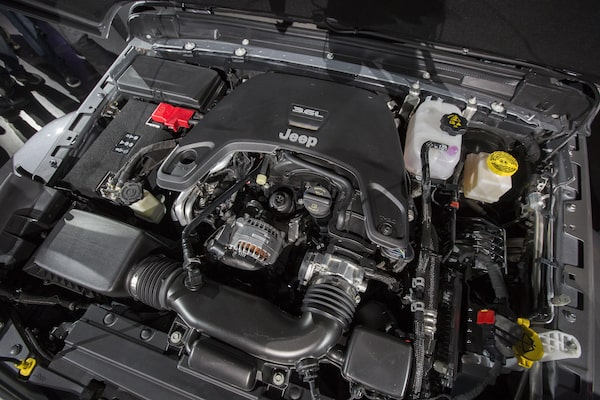
The Jeep Gladiator that drove up the steps and onto the stage at the Los Angeles Auto Show was an instant hit.FCA US LLC
As soon as the latest generation of the Jeep Wrangler debuted last year, Jeep lovers wanted to know about a pickup version. There was a Jeep truck of some sort for 45 years, but nothing’s been produced since the final Comanche in 1992.
So the Jeep Gladiator that drove up the steps here and onto the stage at the Los Angeles Auto Show was an instant hit. To the casual eye, it’s a Jeep Wrangler with a flatbed stuck on the back, but while it shares powertrains and drivetrains and a cabin with the four-door Wrangler Unlimited, it is a separate model. It will come on sale next spring, with pricing announced closer to the date.
Like current Wranglers, there will be four trim levels: Sport, Sport S, Overland and Rubicon. The Gladiator is only available as a four-door; it’s 78 centimetres longer and its wheelbase is 49 cm. longer, to accommodate the five-foot steel flatbed and aluminum tailgate. There’s enough space in the back to carry a pair of motorcycles, and the Gladiator’s payload is increased to 725 kg (1,600 lbs.) from the 522 kg of the Wrangler Unlimited. Maximum towing capacity is also greatly increased, to a potential 3,469 kg (7,650 lbs.) from the current 1,588 kg rating.
Gladiator uses a five-link coil suspension at both front and rear. It’s similar to the Wranglers except at the back axle – still a solid Dana 44 unit – the system includes two upper and two lower forged-steel control arms with a track bar. Everything under there is retuned for the different balance of the longer wheelbase, and there are four skid plates for better protection. The even-tougher Rubicon has rock rails at the sides and on the corners.

The Gladiator will come on sale next spring, with pricing announced closer to the date.David McNew/Getty Images

Like the Wrangler, the Gladiator's doors, roof and even windshield can be removed for Jeep’s unique open-air experience.FREDERIC J. BROWN/AFP/Getty Images
“This is the most anticipated Jeep product in recent history,” said Tim Kuniskis, who was appointed in October as FCA’s head of the Jeep brand.
“We know our customers have no shortage of gear, and an abundant desire to take it with them. … For that, the versatility of a bed was a natural fit, and as (chief designer) Mark Allen puts it, Jeep and truck go together like peanut butter and jelly, bacon and eggs, and Guns N’ Roses.”
Like the Wrangler, the Gladiator will be offered first with a 3.6-litre Pentastar V-6 engine, capable of 285 hp and 260 lbs.-ft. of torque. A 3.0-litre EcoDiesel V-6 engine will be available in 2020, capable of 260 hp and a huge 442 lbs.-ft. of torque. The Wrangler’s new 2.0-litre turbocharged engine will not be found in the Gladiator, but there will still be a choice of either an eight-speed automatic or a six-speed manual transmission.

All the interior comforts and amenities introduced on the new Wrangler JL edition will be available for the Gladiator.FCA US LLC

The Gladiator will be offered first with a 3.6-litre Pentastar V-6 engine, capable of 285 hp and 260 lbs.-ft. of torque.David McNew/Getty Images
Again like the Wrangler, the Gladiator’s doors, roof and even windshield can be removed for Jeep’s unique open-air experience, and all the interior comforts and amenities introduced on the new JL edition will be available for the Gladiator.
The market for mid-size pickup trucks is much larger in the United States than in Canada, where Toyota’s Tacoma and Chevrolet’s Colorado hold sway against the soon-to-be-introduced Ford Ranger. Now Kuniskis hopes to enlarge it even more with the Gladiator.
“This brand hasn’t grown by bringing a segment to Jeep – we’re growing by bringing Jeep to a segment,” he said. “This segment has doubled in just the last four years (to 450,000 vehicles sold in 2017), and we see it growing to well over a half-million deliveries in the next few years.
“This is a brand that has adapted to the market by adopting consumers who aren’t looking for vehicles, transportation or appliances. No – they’re looking for Jeeps,” he added. “And we’ve done it by feeding the aspirations of the active (and) fuelling the fantasies of modern-day commuters.”

There’s enough space in the back to carry a pair of motorcycles.FCA US LLC
Shopping for a new car? Check out the new Globe Drive Build and Price Tool to see the latest discounts, rebates and rates on new cars, trucks and SUVs. Click here to get your price.
Stay on top of all our Drive stories. We have a Drive newsletter covering car reviews, innovative new cars and the ups and downs of everyday driving. Sign up for the weekly Drive newsletter, delivered to your inbox for free. Follow us on Instagram, @globedrive.